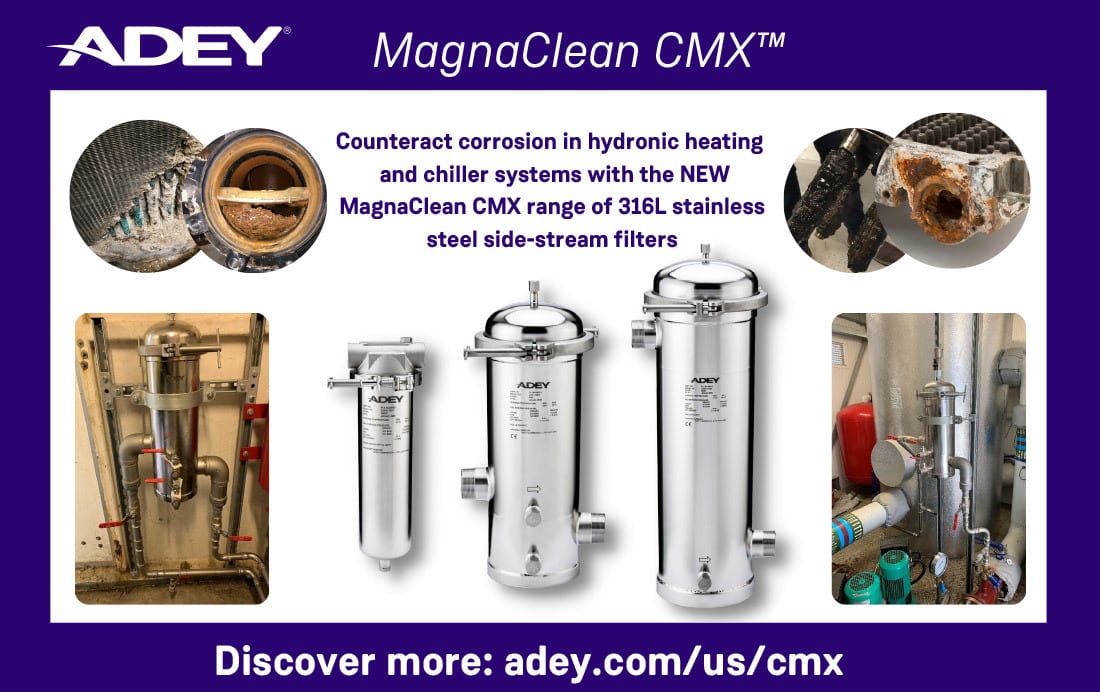executive’s column
How do I decide?
Ensure you’re making the correct system selection.
By Sean Cleary
It doesn’t matter if you’re constructing your single-family dream house or designing and building a large commercial piece of real estate — there are so many decisions that need to be made. The decisions will have important implications as to the cost, sustainability, life and comfort of the people living or working in the facility. It is vital that you choose wisely. To do so, you need the most up-to-date information, which will allow you to come to the correct conclusion. For this discussion, we will focus on what I feel is the most important piece of the design puzzle related to the comfort of individuals living or working within the space — the HVAC system. I like to refer to it as the comfortable living system. To me, this is the make-or-break part of any living space in which I will be spending time. Now that we know what we are focused on, we can begin asking the questions that will allow us to receive the information we need to make the correct system selection that works in our personal space and fits our needs. Thankfully, the information is out there if you know where to look for it. Let’s put up some basic questions that will start us down the path and get us a better understanding of what is needed to make a proper judgment.

Sean Cleary
vice president, industry programs and Backflow Prevention Institute operations for IAPMO
We can have comfort and efficiency while saving the planet and reducing our carbon footprint. We just need to do our homework and use the tools available to us.
What is the climate in our location? The heating and cooling needs for a facility in Kodiak, Alaska, are nothing like those of a building in Orlando, Florida. We need to take a close look at specific location requirements. One size or system does not fit all. This allows us to look at a design temperature and get an idea of the actual heating and cooling requirements for a year-round basis. The heating and cooling load must be considered before we look at specific products or system types. Once we know this, we can move on to looking at the building design, insulation requirements and other factors that will affect the heating and cooling load.
Which energy source will be available to us? Are we looking at choosing the most environmentally safe source or the one with the lowest cost point? Are we thinking long- or short-term paybacks? Is district heating and cooling an option? Solar, wind, fossil fuel, geothermal — the list of options can seem endless. What is correct for me and my facility? Am I looking to save the planet or to simply pick the low-cost option? Answering that question can be difficult.
We all want to save money, which is simply human nature. I also truly believe that most of us would like to minimize our carbon footprint and do what we can to save the planet. We are looking for a system that, once it is installed, has reasonable service and maintenance costs and that will provide long-term life and reliability. It also must deliver comfort when providing either heating or cooling. In some cases, the system will need a mixture of each to ensure comfort in our facility.
Going on a trip down memory lane, I have encountered a number of HVAC systems and products. As an almost 63-year-old man living in Northeastern Pennsylvania, I have lived or worked in facilities that have been heated and/or cooled using many different fuel sources and system types. That, along with the fact that I have been working in the plumbing and mechanical trades for the past 46 years, gives me a more informed perspective than the average person. Mechanical systems fascinated me from an early age.
From a youthful age until I was in my early teens, I lived in an apartment house that was heated with a hand-fired coal warm-air heating system. Air conditioning was nonexistent, as was thermal insulation in the walls, windows or ceilings — not very efficient or comfortable when the weather was cold or warm. Cooling was provided with box fans and open windows. When my parents purchased an old farmhouse, we then went to a coal stoker with steam heat and old-style column radiators for a number of years. The only advantage of the coal as a fuel source was we were able to use the ashes to salt our driveway in the winter for help in dealing with the ice buildup. The cooling and fresh air were again provided with windows and box fans. When the steam boiler developed a leak, the unit was replaced with an oil-fired steam boiler to provide the necessary heat. This was when it became clear to me that system piping design was critical because while the coal boiler provided a slow and steady production of stream, the oil burner’s much faster production of steam and pressure revealed piping problems that resulted in uneven heat and noise issues that were never problems in the past. It made me much more aware of the importance of looking at the entire heating system as opposed to simply looking to the boiler itself.
When I left home and got an apartment, I was introduced to electric baseboard heat and window air-conditioning units. While the heating was comfortable, the cost was alarming. The window units for AC cooled the apartment well but were noisy and also expensive to run. After I met and married my wife, we started a family, and it was time to purchase a home. Our starter home dated back to 1890 with double-boarded construction and no insulation of which to speak. The home had steam heat with column radiators and a natural gas-fired boiler supplying the steam. Two window units again provided air conditioning — one in the master bedroom and one in the living room. Balancing the heating temperatures in a two-story home with a single-pipe stream system was an impossibility, although varying vent sizes on the radiators did allow a small level of control.
After several years when we began to remodel the home, I removed the existing boiler, radiators and steam piping. My time and knowledge in the mechanical trades by this time had increased and I was now searching for both comfort and efficiency. Windows were replaced, insulation was added, a proper heat loss study was conducted and a high-efficiency, condensing natural-gas hydronic heating boiler was added. Several zones were piped in using baseboard fin tubing on the first and second floors, and a hydronic towel warmer was used in the main bathroom. The lack of wall space in the kitchen area created issues and a fan-assisted unit was added under the kitchen cabinets. Split systems were the innovative technology at the time for air conditioning and they were installed in the living areas downstairs with window units in the second-floor bedrooms. Things were not perfect, but the comfort level and efficiency of the home were significantly improved.
Fast forward a number of years to when I got the chance to start from scratch. My wife and I were building a new home from the ground up. The possibilities were endless with the only real restriction being the money we had available to build our dream home. By this time, I considered myself an expert in the field to a certain extent, having installed hundreds of systems of every size and type and having had the good fortune of attending classes and seminars taught by many industry leaders. I had read countless books, articles and training publications on heating and cooling systems and could use that knowledge to install the perfect comfort systems in my forever home. It was 2003, and I had the blueprint ready. I knew the size of the home, the building materials and the room layouts. The climate and design parameters for heating and cooling loads were known factors. The question was now which type of system should I look to install?
I needed both heating and cooling installed in the new home. The home was being built in a new development with houses being constructed on the lots on either side of my property. To my left was a two-story, four-bedroom house and to my right was a ranch-style home. Both of these homes were being built using direct-vent natural gas forced-air units with A-Coils installed on the furnaces and the ductwork being used for both heating and cooling. I was looking to go in a different direction. I wanted true comfort this time.
I decided to go with radiant heat throughout the living space and garage areas. Since floor types would range from hardwood to ceramic tile to carpet and concrete in the basement and garage, there would be a number of heating zones using several different temperatures. The first-floor tubing was installed stapled up to the subfloor in reflective panels, and the other areas had the tubing installed in the concrete. Insulation placement underneath the tubing and in the perimeter walls was a critical step to ensure system efficiency. A high-efficiency, direct-vent natural gas boiler was selected as the heat source and a 120-gallon indirect water heater would supply domestic hot water to the home. Snow-melt in the front sidewalks was planned using a flat plate heat exchange to separate the antifreeze mixture in the sidewalks from the rest of the radiant system liquid.
Air conditioning for the home would be provided by two separate air handlers and compressors, one on the first floor with the ductwork in the attic areas and one in the basement level with ductwork in the ceiling. Radiant in-floor heating allowed us to utilize our floor plans in any way we desired. The installation costs were higher than the forced-air systems used in many new homes in the area, but since I was performing the installation, the cost was more than manageable. With my wife assisting on the PEX Tubing Uncoiler, loop after loop of tubing was installed. The installation was completed, and the system has performed well since that time. Our home is both comfortable and efficient year-round. I made the correct decision in 2003.
What if I asked the same question today, in the year 2022? Would a boiler make sense now? Does a heat pump look like a better option? In 2003, many individuals in the industry had a low opinion of the technology for heating in areas like the one in which I live. To this day, many people of my generation in the field would never consider anything besides a fossil-fuel boiler or furnace for heating needs. I hear old-timers at the supply houses who would like to go back to simple millivolt systems and chimney-vented heating boilers that were far easier to troubleshoot and repair. At one time, I might have also remained closed-minded about improvements and innovation in the HVAC industry, but I have an advocate for new HVAC technology close to me — my youngest son, Michael, decided to follow me into the mechanical trades after finishing college. He became a pipefitter apprentice, and since that time, has become a journeyman pipefitter working in the controls and service industry. He is always looking for the better mousetrap and has taught me to look at innovation in real-time and keep an open mind on modern technology and improvements to existing products and systems.
We can have comfort and efficiency while saving the planet and reducing our carbon footprint. We just need to do our homework and use the tools available to us. That starts with the building owners and developers. It then works its way to designers, engineers and manufacturers, arrives at contractors and tradespeople, and finally ends up with the end-user of the facility. If the selection process is flawed at the beginning, then the entire effort is destined to fail.
The good news is we have tools available to make the correct selection. We can compare different systems, their installation and maintenance costs. We can also look at their efficiency and operating costs in real-time and in the climate and temperature range for almost any given location. Think of the power in that tool. I am referring to the B.E.S.T software. This Building Efficiency Software Technology may be downloaded for free at https://forms.iapmo.org/hiac/software_register.aspx
Once the location is chosen and the building design is completed, this tool can be used to select the best system type to ensure the most efficient and comfortable HVAC is selected and installed. Not using all the available tools does a disservice to everyone involved in the entire process. The B.E.S.T. software is a living document that changes to remain up to date and relevant in order to provide the data necessary to make the most educated decision possible.
So, it is possible for an old dog to learn new tricks. I am living proof of that.
Sean Cleary is vice president of industry programs and Backflow Prevention Institute operations for IAPMO. He is also a licensed master plumber from Scranton, Pennsylvania. Over the course of his 42-year career, he has worked in all phases of the cross-connection, plumbing and mechanical industries. He is a graduate of the United Association Instructor Training Program. Cleary is a past president of ASSE, and also served as the chairman of the ASSE Cross-Connection Control Technical Committee for more than 10 years.

